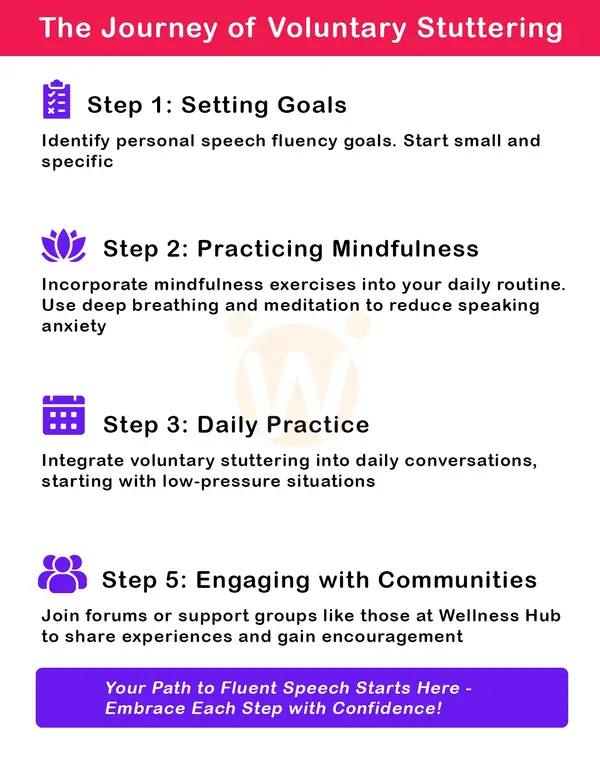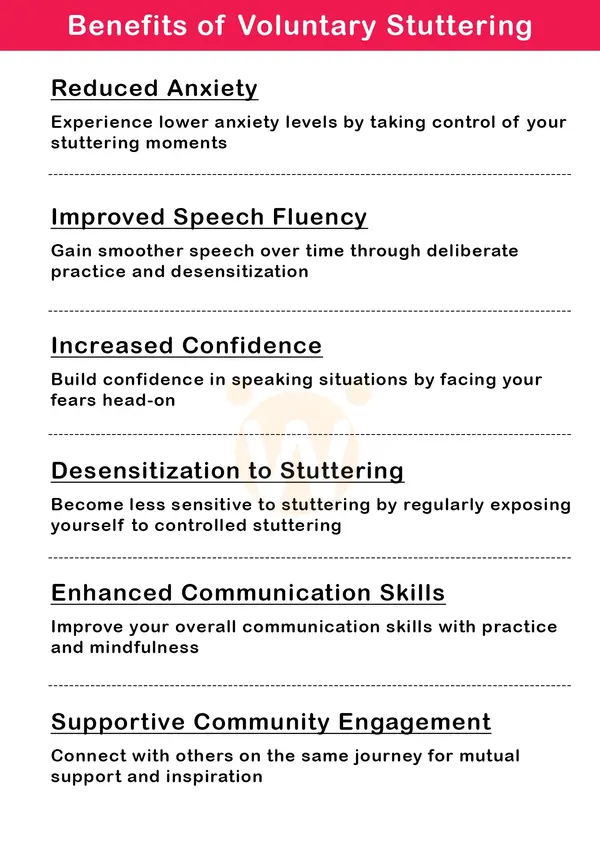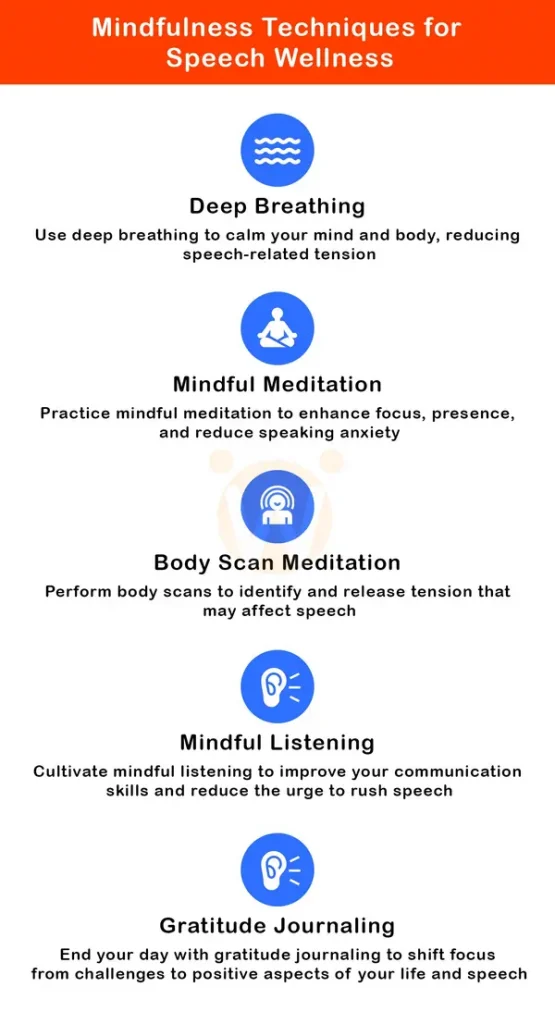Unlocking Fluency: The Surprising Benefits of Voluntary Stuttering
By Rajini D
Last Updated: February 22, 2024
Have you ever imagined that the key to unlocking smoother speech might actually involve…stuttering more? It sounds counterintuitive, right? But that’s exactly where the concept of voluntary stuttering steps in – a method that turns traditional views on overcoming speech disfluencies on their head. Instead of tirelessly striving to eliminate every stutter, voluntary stuttering encourages embracing them, but on your terms. This approach is not just about stuttering; it’s about regaining control of your speech and, by extension, your confidence.
If you’re on a quest to navigate through the maze of speech fluency challenges, you’re not alone. Many are searching for that breakthrough strategy that feels tailored just for them, something beyond the conventional advice scattered across the internet. Voluntary stuttering might just be that unexpected ally in your journey towards fluency. It’s not a one-size-fits-all solution, but it’s a path marked by self-discovery, acceptance, and, ultimately, empowerment.
Discover a variety of speech therapy techniques that can complement your journey toward fluency.
Understanding Voluntary Stuttering
What is Voluntary Stuttering?
Voluntary stuttering is a technique that may sound a bit unusual at first: it involves deliberately stuttering during speech. Imagine you’re about to start a conversation, and instead of trying to avoid stuttering at all costs, you choose to stutter on the first few words on purpose. For instance, if you were introducing yourself, it might look like this: “My n-n-name is Alex.” This method is not about increasing your stuttering moments but controlling them in a way that reduces the anxiety and unpredictability associated with spontaneous stuttering.

Learn more about other speech and language disorders to better understand how voluntary stuttering can help.
Starting Voluntary Stuttering: A Step-by-Step Guide
| Step | Action | Goal | Progress Tracking |
|---|---|---|---|
| Identify Scenarios | Find daily situations where you feel most at ease to speak. | To create a safe environment for practice | Keep a list of scenarios where you practiced voluntary stuttering and how comfortable you felt. |
| Choose Words/Sounds | Select specific words or sounds that you will intentionally stutter on. | To plan your stuttering moments | Record the words/sounds chosen and any patterns in your comfort or difficulty with them. |
| Daily Practice | Integrate voluntary stuttering into your conversations in these scenarios. | To build consistency and confidence | Note the frequency of your practice and any changes in your speech fluency |
| Progress and Reflections | Journal about your experiences, feelings, and any observed changes. | To reflect on and understand your journey | Maintain a diary or journal to track your progress, challenges, and reflections over time. |
Boost your technique with insights from best online speech therapy in Hyderabad.
The Science Behind the Strategy
So, why does deliberately stuttering help? The concept is rooted in the principles of speech-language pathology and psychology. By choosing to stutter, you’re taking control of your speech pattern, which can paradoxically lead to a reduction in involuntary stuttering. It’s akin to a fear-facing strategy in psychology, where exposure to the feared stimulus in a controlled way reduces the fear response over time. Speech therapists have observed that this technique helps people who stutter feel more in control during conversations, reducing the psychological stress associated with speaking and, in some cases, even improving fluency over time.
Dive deeper into how to overcome test anxiety as a related fear-management strategy.
The Benefits of Embracing Your Stutter
Desensitization: Facing the Fear
One of the most significant benefits of voluntary stuttering is desensitization. Regularly facing your fear of stuttering can decrease the anxiety that surrounds it. Think of it like this: the more you practice voluntary stuttering, the less frightening and more manageable stuttering becomes. This process helps break down the stigma you’ve attached to stuttering, making it a less daunting aspect of communication. It’s about changing your relationship with stuttering from one of fear and avoidance to acceptance and management.
Control and Confidence
When you choose when and how you stutter, you’re essentially taking the reins of your speech. This sense of control is empowering. It shifts the narrative from being a passive participant in your speech patterns to an active director of how you communicate. This empowerment fosters confidence, not just in speech, but in your ability to handle challenging situations. Confidence in speech translates to a more assertive presence in conversations, interviews, and presentations, making you feel more competent and self-assured.
Bridging the Sections
As we delve into these concepts, it’s crucial to remember that the journey toward fluency is deeply personal and varies from one individual to another. Wellness Hub recognizes the uniqueness of this journey and strives to provide resources and support tailored to your needs. Whether it’s through exploring innovative techniques like voluntary stuttering or offering guidance on wellness practices that complement your speech therapy goals, we’re here to support you every step of the way.
Understand the psychological impact of stuttering and how voluntary stuttering can change your relationship with it.

Practical Applications and Strategies
Getting Started with Voluntary Stuttering
Starting with voluntary stuttering can feel a bit daunting at first, but here are some beginner tips to help integrate this technique into your daily conversations smoothly:
- Start Small: Begin by practicing voluntary stuttering in low-stress situations, such as talking to yourself in the mirror or conversing with a close friend or family member. This can help build your comfort level.
- Plan Your Stutters: Decide on specific words or sounds where you will intentionally stutter. This planning gives you a sense of control over your speech pattern.
- Use Tools and Techniques: Incorporate techniques like slow speech, soft starts, or light contacts to make your voluntary stuttering as comfortable as possible.
- Reflect and Adjust: After each conversation, take a moment to reflect on how it felt to voluntarily stutter. What worked well? What could be improved? Adjust your approach accordingly.
- Seek Support: Consider joining a support group or working with a speech therapist who understands voluntary stuttering. Sharing experiences and tips with others can be incredibly beneficial.
For additional support, consider online speech therapy to guide you through the process.
Setting Realistic Goals
Setting achievable goals is crucial in your journey with voluntary stuttering. Here’s how to ensure your goals are realistic and tailored to your progress:
- Define Clear Objectives: Whether it’s to voluntarily stutter in a certain number of conversations per day or to practice specific techniques, having clear, measurable goals can help track progress.
- Celebrate Small Wins: Recognize and celebrate every step forward, no matter how small. Each effort is a step towards greater confidence and fluency.
- Be Patient and Persistent: Remember, progress takes time. Be patient with yourself and stay committed to your practice, even when it feels challenging.
- Adjust Goals as Needed: As you grow more comfortable with voluntary stuttering, it’s okay to adjust your goals to keep challenging yourself and advancing your skills.
Transforming Challenges into Opportunities
Beyond Techniques: The Emotional Journey
Embracing voluntary stuttering is more than just a speech technique; it’s a pathway to emotional and psychological growth. This journey involves confronting fears, dismantling personal stigmas associated with stuttering, and ultimately, reshaping your self-identity. Recognize that this process can stir up a mix of emotions, from frustration to liberation, and it’s all part of the transformative experience. The ultimate goal is not flawless speech but a harmonious acceptance of your unique voice.
Community and Support
No one should have to walk this path alone. Finding a supportive community can be a game-changer in your journey with voluntary stuttering. Whether it’s joining forums, participating in speech therapy groups, or engaging in discussions on platforms facilitated by Wellness Hub, being part of a community offers a sense of belonging and understanding. Sharing experiences, challenges, and victories with others who understand can significantly enhance your motivation and resilience.
Remember, every step taken with voluntary stuttering is a step towards not just improved fluency but also a more confident and empowered self. At Wellness Hub, we’re committed to supporting you through every phase of this journey, offering resources, guidance, and a community that understands.
Explore the role of speech therapists in online settings to enhance your speech fluency journey.
Mindfulness Practices for Speech Wellness

Mindfulness and speech fluency intersect at the point of self-awareness and regulation. Here are some mindfulness techniques that you can incorporate into your daily routine to support your speech wellness journey:
- Breathing Exercises: Start with simple deep breathing exercises. Focus on taking slow, deep breaths, inhaling through your nose, and exhaling through your mouth. This can help reduce the physical tension that often accompanies stuttering moments, creating a more relaxed state for speaking.
- Mindful Meditation: Dedicate a few minutes each day to meditation. Find a quiet space, close your eyes, and focus on your breath. When your mind wanders, gently bring your attention back to your breathing. This practice enhances your ability to stay present and focused, qualities that are beneficial during speaking situations.
- Body Scan Meditation: This involves paying attention to different parts of your body, in turn, noticing any sensations, tensions, or relaxation. Starting from your toes and moving up to your head can help you become more aware of where you hold stress and learn to release it, which can positively impact speech fluency.
- Mindful Listening: Engage in conversations with the intent of listening mindfully. Focus fully on the speaker, their words, and the meaning behind them, rather than planning your response. This can help reduce anxiety about speaking and improve your communication skills.
Mindfulness Techniques for Speech Wellness
| Technique | Purpose | Daily Integration Tips |
|---|---|---|
| Deep Breathing | To reduce stress and physical tension before or during speaking. | Practice deep breathing for 5 minutes at the start of your day and before any speaking event. |
| Mindful Meditation | Enhances focus and presence, reducing anxiety associated with stuttering. | Dedicate 10 minutes each morning or evening to mindful meditation, focusing on your breath. |
| Body Scan Meditation | Helps identify and release tension in the body that can impact speech. | Perform a body scan before bed, noting any tension and consciously relaxing each body part. |
| Mindful Listening | Improves listening skills, reducing the urge to speak hastily. | In conversations, focus entirely on the speaker, noting the content and your reactions. |
| Gratitude Journaling | Shifts focus from challenges to positive aspects, enhancing well-being. | End your day by writing down three things you’re grateful for, including any speaking successes. |
Incorporate mindful meditation techniques into your daily routine for enhanced speech and overall well-being.
Engaging with Your Journey
Embarking on a journey toward speech improvement is a deeply personal and, at times, challenging path. It requires persistence, courage, and a lot of heart. It’s natural to encounter moments of frustration or to feel your motivation wane.
Tips for Keeping Motivated
- Set Clear, Achievable Goals: Start with small, manageable goals that you can gradually build upon. Celebrating these smaller victories can provide a sense of progress and keep you motivated for the next challenge.
- Track Your Progress: Keep a journal or log of your practice sessions, successes, and areas for growth. Reflecting on where you started and how far you’ve come can be a powerful motivator.
- Seek Support: Remember, you’re not alone. Engage with communities like those found at Wellness Hub, where you can share your experiences, challenges, and successes with others who understand your journey.
- Incorporate Variety: Keep your practice sessions fresh and interesting by incorporating different techniques and activities. This could range from mindfulness exercises to speech therapy games or even new speaking environments.
- Reward Yourself: Set up a reward system for reaching milestones. This could be something small, like treating yourself to your favorite coffee, or something bigger for larger achievements.
- Stay Educated: Continue to learn about speech improvement techniques and stories of others who have navigated similar paths. This not only provides practical strategies but also serves as a reminder that improvement is possible.
- Embrace Setbacks as Learning Opportunities: It’s okay to have off days. What’s important is to view them as opportunities to learn and grow, not as failures. Reflect on what might have led to the setback and how you can adjust your approach moving forward.
- Visualize Success: Spend a few minutes each day visualizing yourself speaking fluently and confidently in various situations. This mental rehearsal can boost your confidence and motivation.
- Remember Your ‘Why’: Keep in mind the reasons you started this journey, whether it’s to feel more confident in social situations, to advance your career, or simply to express yourself more freely; reminding yourself of your ‘why’ can reignite your motivation.
- Be Kind to Yourself: Show yourself the same compassion and encouragement you would offer a friend. Celebrate your effort, resilience, and the courage it takes to work toward speech improvement.
Conclusion
As we conclude our exploration of voluntary stuttering, remember that this technique offers a unique way to approach speech fluency. It’s about embracing stuttering on your terms, reducing anxiety, and regaining control over your speech. Keep an open mind and experiment with this method; progress, not perfection, is the goal.
Wellness Hub is here to support you on this journey. Our community and resources are designed to complement your efforts toward better speech fluency. Whether you’re looking for strategies, encouragement, or just someone to talk to, you’ll find it with us.
Thank you for joining us on this journey. Embrace the process, celebrate your achievements, and remember, you’re not alone. Together, we can make strides towards smoother speech and greater confidence.
Frequently Asked Questions:
1. What is voluntary stuttering?
Voluntary stuttering is a speech therapy technique where individuals deliberately stutter on certain words or sounds. It’s used to reduce the fear and anxiety associated with stuttering by taking control of the speech pattern in a controlled manner.
2. How can voluntary stuttering help improve speech fluency?
By intentionally stuttering, individuals can reduce the negative emotional response to stuttering, become desensitized to the act of stuttering itself, and gain greater control over their speech. This approach can lead to improved speech fluency over time.
3. Is voluntary stuttering suitable for everyone who stutters?
Voluntary stuttering can be beneficial for many people who stutter, but its effectiveness can vary based on individual experiences and the nature of their stuttering. Consulting with a speech therapist is recommended to determine if it’s a suitable technique for you.
4. Can mindfulness techniques complement voluntary stuttering practices?
Yes, mindfulness techniques such as deep breathing exercises and meditation can complement voluntary stuttering by reducing stress and increasing focus, making it easier to practice and benefit from voluntary stuttering exercises.
5. How do I start practicing voluntary stuttering?
Begin by choosing low-pressure speaking situations where you feel comfortable. Plan ahead which words or sounds you will stutter on, and gradually incorporate this practice into more challenging conversations. Tracking progress and setting realistic goals can also help.
6. Where can I find support and resources for voluntary stuttering?
Wellness Hub offers a range of resources and a supportive community for individuals exploring voluntary stuttering. From articles and guides to forums and support groups, you can find the encouragement and information you need to pursue speech fluency.
7. How long does it take to see improvements with voluntary stuttering?
Improvements can vary greatly among individuals and depend on factors like the frequency of practice, the severity of stuttering, and the use of complementary techniques. It’s important to maintain consistent practice and patience throughout the process.
8. Are there any success stories of people improving their speech through voluntary stuttering?
Yes, many individuals have reported significant improvements in their speech fluency and confidence after incorporating voluntary stuttering into their practice. While experiences vary, these success stories offer hope and inspiration for others on a similar journey.
9. Can voluntary stuttering reduce the anxiety associated with stuttering?
Absolutely. One of the primary benefits of voluntary stuttering is its ability to reduce the anxiety and fear related to unexpected stuttering moments by making stuttering a controlled and intentional act.
10. How can I maintain motivation while practicing voluntary stuttering?
Setting achievable goals, tracking progress, engaging with supportive communities like Wellness Hub, and celebrating small victories can all help maintain motivation throughout your journey toward speech fluency.
About the Author:
Rajini Darugupally
M.Sc., Speech-Language Pathologist (9+ years of experience)
Rajini is a passionate and dedicated Speech-Language Pathologist with over 9+ years of experience, specializing in children’s developmental speech and language disorders and rehabilitation in adults. Driven by a desire to empower each individual to find their voice, Rajini brings a wealth of experience and a warm, genuine approach to therapy.
At Wellness Hub, she thrives in a team environment that values innovation, compassion, and achieving results for their clients.
Connect with Rajini to learn more about how she can help you or your loved one find their voice.
Book your Free Consultation Today
Parent/Caregiver Info:
Client’s Details:
* Error Message








